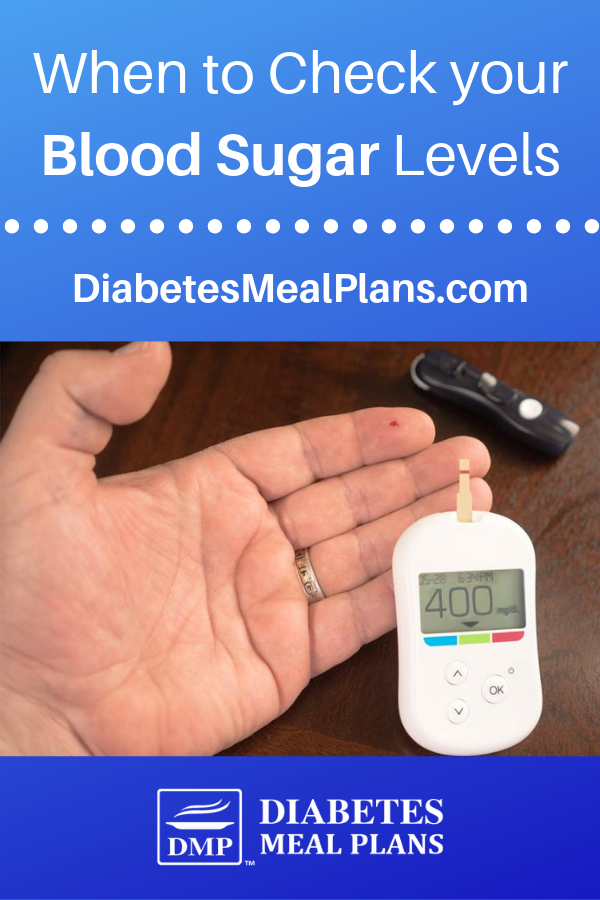Reader question:
I think my blood sugar is all over the place and I haven’t really been testing it regularly. I need to get better control I think, but when should I check my blood sugar levels because I’m not really sure how often or when is best?

First, let’s just recap normal blood sugar levels so you know what to aim for.
You want to aim for 70-110 (4-6.1) fasting or before meals, and under 140 (7.8) after meals.
How Often To Test?
There is wide variation in the frequency of testing blood sugar.
Most diabetes organizations recommend you test at least 3-4 times per day. We’d encourage you to do the same – take your fasting blood sugar (first thing in the morning), and do one paired test per day (like before and after lunch or dinner).
Sometimes it can be even better if you test more, at least until you get good control of blood sugar levels, but 3-4 times is usually sufficient to start seeing patterns emerging.
Should I test even if I don’t take insulin?
Yes, we encourage you too.
Sometimes your doctor may not prescribe self-monitored testing but it’s a great way to get immediate feedback on your behavior so you can adjust things like diet or exercise to get better results.
You can ask your doctor to support it as you may be able to get a free monitor. If not, we’d encourage you to consider purchasing one of your own, as self-monitoring is going to help you a lot.
What is the best monitor? See this info here.
Is there a best method to testing?
We recommend at least 3 tests per day, or at least 3 tests every second to third day.
Fasting blood sugar – taken first thing in the morning before any meals. Most people do this regularly, on a daily basis.
Do one paired test per day – like before and after lunch or before and after dinner. You can do this daily, monitoring either lunch or dinner, or some people may do paired tests every 2nd or 3rd day.
☛ If you’re newly diagnosed or trying to gain better control, then we recommend 3 tests per day – fasting and one paired test daily.
➣ If you’re traveling fairly stable you may log fasting blood sugar daily, and one paired test 2-3 times per week.
✷If you’re limited by budget for testing equipment, we recommend changing the routine. Don’t always do fasting blood glucose, as this fasting blood sugar can commonly be high. You also want to assess how your after meal levels are, so you can get a better estimation of how your overall levels are tracking.
How to monitor in pairs? (paired test)
Step 1: Take your blood sugar level before a meal. Write it down.
Step 2: Eat your meal, setting your timer for 2-hours from your first bite of food.
Step 3: Take your blood sugar level 2-hours after your meal. Write it down.
Step 4: Evaluate your readings. Are they within the healthy range? Or could you make some adjustments to improve these readings?
Monitoring in pairs is a very useful way to compare foods, especially carbs, and see how they influence your blood sugar levels. You can then use that information to make different choices and alter your diet to get better results.

📌 IMPORTANT! Log your numbers
The most important thing is you write down your results so you can watch patterns emerging in your numbers.
Are your numbers high after meals? You can modify your diet or exercise routine to get them lower, especially the things you eat.
To lower blood sugar levels, focus on reducing carbs, and choosing the right carbs. Keep testing and see what happens.
What you will begin to notice if you start doing paired monitoring is that certain foods may be making your blood glucose levels higher. So this practice is really all about bringing more awareness into your eating routine so you can discover how you react and control your blood sugar level better. This is important because some people are more carbohydrate sensitive than others.
Are your numbers slowly getting lower? That’s great, keep doing what you’re doing!
Have you seen a sudden increase in your numbers? Could it be stress, sleep or illness affecting your numbers?
Self-monitoring is very important to give you feedback on your progress. If you’re not using it already, we encourage you to do so. Use the tips above to get the best out of your blood sugar monitoring routine.

MichelleP
Great advice on using the MyFitnessPal app. I only started using it a few days ago & love it. Much easier and probably more accurate calculating of nutrients in all the foods.
I did notice though that the suggested carb/protein/fat ratios are different in the app than they are on this plan. They are also different than the ADA guidelines.
My insurance pays for just 1 strip a day because I am pre diabetic. I bought generic strips at the pharmacy 50/$9 so I can test more. I also paid for a VIP membership here. It seems work and expense but very worth it as an investment in health.
Sue
Thank you for all your helpful ideas, I am type 2, have cut out carbs and Sugar and although my sugar levels are more or less the normal level of a non diabetic I’m still classed as being diabetic as my HBA1C at my last test was 6.5%. I am helping myself by diet alone, so your food guide is perfect thank you .
Felix
Sue I have seen your note. I am a type 2 also and will appreciate if you would help me to control my sugar levels, diet alone? tell me about it.
Thanks.
Jedha
HI Felix, Sue followed our diet food list over here. You can also find some great info to help you get started over here.
Agnes
Useful site I like
Samantha
Good day. ..
I want to know why on a fasting (waking after a sleep of 6-8 hrs ) my sugar testing is between 13-15?
I drink only water upon waking and stil get high readings… it’s so depressing ?
Is it me or could there be a fault with my sugar testing machine (acue check)?
Kind regards Samantha Phillips
Jedha
It’s a common issue Samantha so don’t stress or get too upset. Take a look over here for some great info on why it occurs and how you can help reduce it.
Ellis Girrard
That is just the type of info I have been looking for…realy explains alot…thanks heeps!
Jedha
Great to know it’s helpful Ellis :)
Meg
Instant access? Doesn’t seem like it. Its been 15 minutes and nothing has happen in my effort to download your offered chart. Just as spinning wheel.
Jedha
Hi Meg, Check your email inbox. If you have already been a subscriber it will be sent directly to you. Apologies for the confusion and hope you get it :)